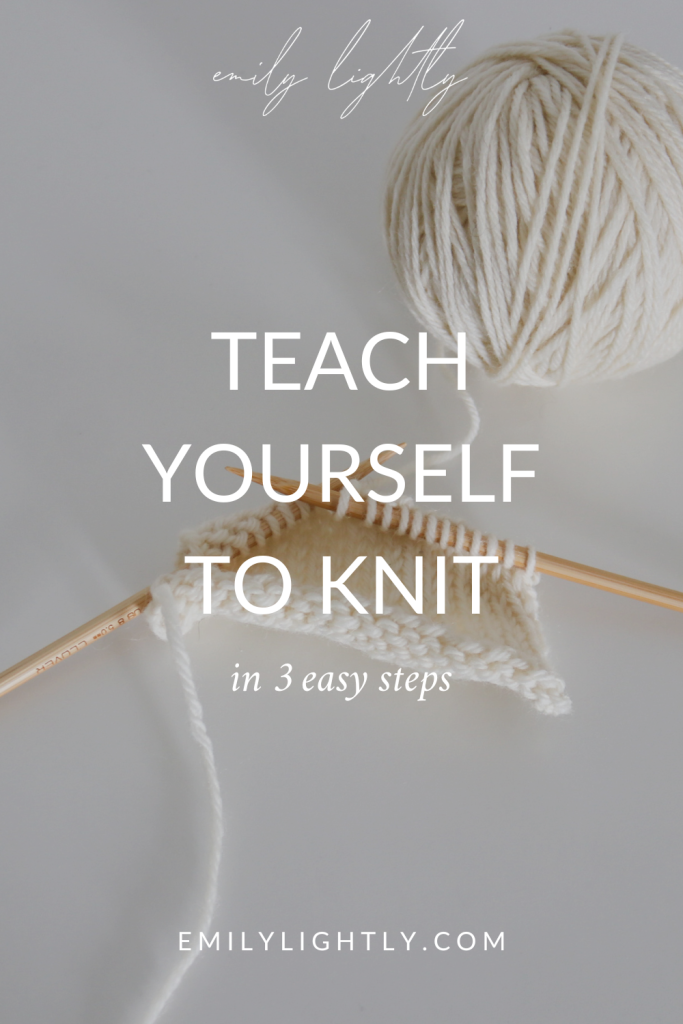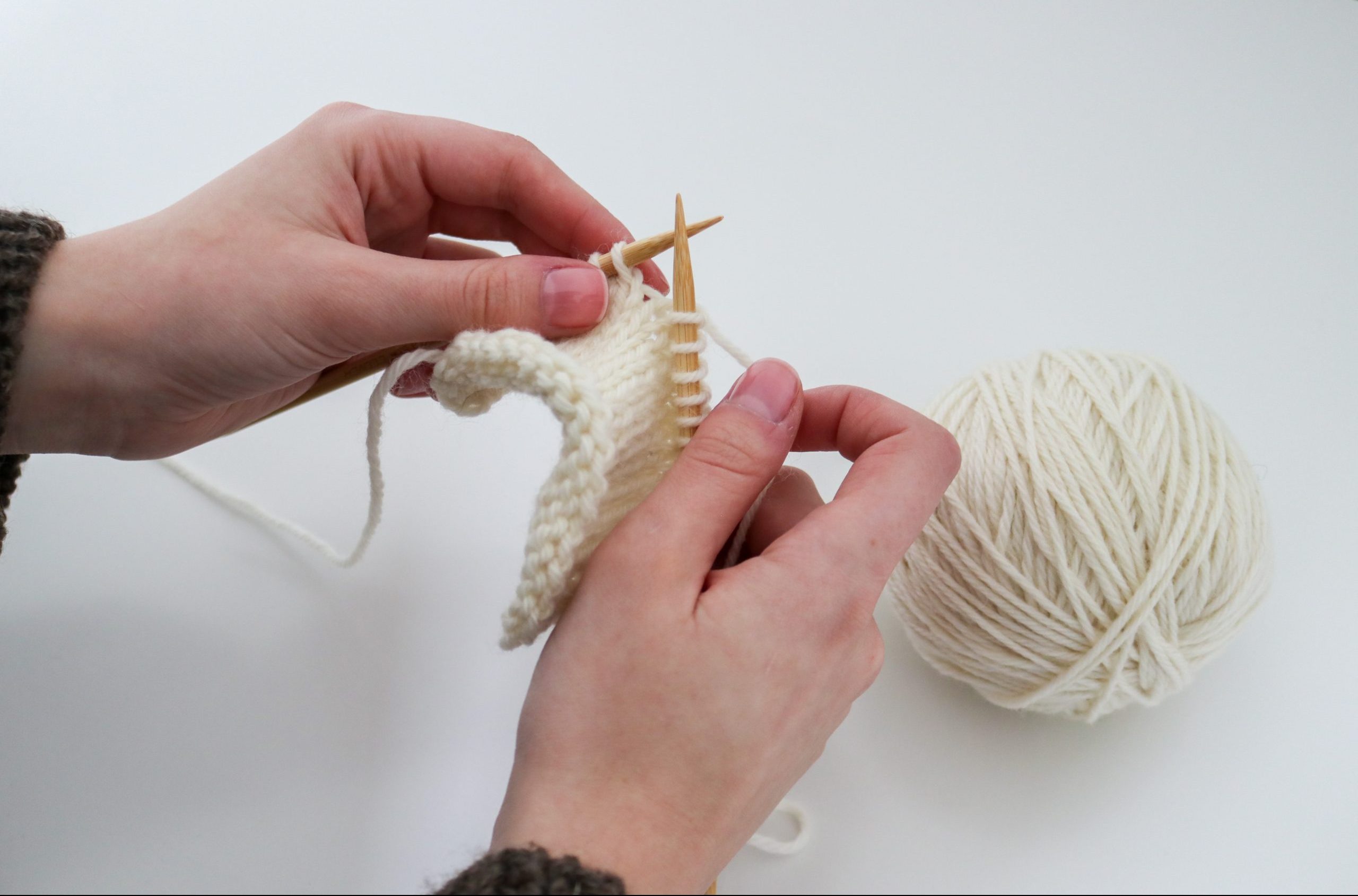Are you looking for a new crafty hobby to pick up this year? If you haven’t tried knitting yet, I couldn’t recommend it more! I picked up knitting a few years ago shortly after getting back into sewing, and I became totally addicted. It’s both challenging yet relaxing, and I love that it offers a much slower pace (for me, anyway – it typically takes me anywhere from 1-3 months per item depending on the complexity). And it’s never been easier to start than it is now, given the wealth of information and tutorials available on the internet. So if you’re a crafty DIYer who isn’t afraid to jump in and learn something new, this article is for you! I am going to give you three simple and easy steps to follow in order to teach yourself this amazing skill.
Before we jump in, if you’re not the self-learning type and prefer a little more detailed instruction, that’s totally okay! Everyone has different learning styles and preferences. If you’re looking for a more comprehensive and instructor-led approach to learning to knit, I’ve created an online course called Learn to Knit for Complete Beginners that teaches you absolutely everything you need to know as a beginner knitter. So you can check that out if you’re interested, otherwise let’s continue on with the three steps!
Step 1: Pick a Project
The first thing you’re going to do is pick a project, but not just any project. You want something that you’re actually interested in and that gets you excited, otherwise it’s easy to become bored or unmotivated and leave your project unfinished. The best place in my opinion to find knitting patterns is Ravelry. You can use their advanced search function to really drill down and specify the exact search parameters that you want to find suitable patterns for what you want to do.
Whatever project you choose, you’ll want to make sure that it’s also beginner-friendly. It might look exciting to make a beautiful and intricately cabled fishermen’s sweater, but something so complex can be frustrating even for seasoned knitters and you don’t want to get discouraged right off the bat. Ravelry’s search function includes a filter for difficulty level that goes from 1 (piece of cake) to 10 (impossible). I’d recommend filtering around the 1-3 range in order to find something appropriate, and look for something in an easy stitch pattern like stockinette, basic rib, or garter stitch.
Lastly, I’d also recommend working on something with a heavier-weight yarn (at least worsted weight). Yarn comes in different weights, which is essentially just the thickness of the yarn. It’s a lot easier, not to mention faster, to knit something in heavier weight yarn than a lighter weight because it’s not as delicate or fiddly and it takes fewer stitches to create the same size piece of fabric. So that’s something to keep in mind as you’re choosing your project.
Here are some beginner-friendly projects that I think would be a good place to start:
- Purl Soho Waffle Stitch Washcloth
- Ozetta Towns Sweater
- PetiteKnit Novice Sweater
- Brandi Cheyenne Harper Easie Beanie
- Good Night, Day Nanaimo Cardigan
- Purl Soho Lovely Ribbed Hat
- Darling J’adore Blanket Scarf
Step 2: Gather Your Supplies
Now that you have your beginner-friendly, exciting pattern in hand, it’s time to gather your supplies! One mistake I see a lot of beginner knitters making is just heading to the craft store and picking out some random knitting needles and a ball of yarn without having a specific project in mind or knowing exactly what supplies are needed for a given pattern. It’s important to know that needle sizes directly correspond to yarn weights – so the heavier the yarn, the larger the needles you will need. There are also different types of needles, like straight, circular, and double-pointed, and all serve different purposes.
But don’t let yourself get overwhelmed by all the options – your pattern is going to tell you exactly what supplies you need, including needles (sizes and types), yarn, and any notions (such as stitch markers). You can even bring your pattern along with you to the craft store and have an associate help you pick everything out. If you can’t find the exact yarn suggested by your pattern, you can substitute it with another yarn in a similar weight and fibre, however as a beginner I would recommend using the suggested yarn to ensure you achieve the most similar result to the pattern as intended. A good tool for helping you find appropriate yarns to substitute with is YarnSub.com.
I’d also recommend checking around your local thrift stores for secondhand knitting supplies to be more budget-friendly. When you’re just starting out, it’s best not to invest too much money in case knitting just doesn’t end up being your jam. While it might be worthwhile later on if you really get into it, in the beginning there’s no need to go out and buy the fanciest interchangeable circular knitting needle set that your money can buy. Just keep it simple, pick up exactly what you need, and start small.
As a beginner knitter, the only supplies that I would recommend picking up aside from appropriate needles and yarn for your project are stitch markers (used for marking specific points or stitches in your knitting), a row counter (pretty self-explanatory – for helping you count and keep track of your rows), and a tapestry needle (for weaving in ends). It’s also helpful to have a measuring tape and some scissors nearby.
Step 3: Find Tutorials
All right, this is the final step and the one where you’re really going to have to just jump in and give things a try. Knitting patterns can sometimes look like they’re written in another language with all of the abbreviations, lingo, and numbers; and a lot of the time they will tell you what to do, but not necessarily how to do it. However, don’t let that stop you! Once you have a basic understanding of how patterns work, you’ll be able to read them no problem. And the best part is, whenever you come across a step that you don’t know how to do, I can almost guarantee you that there are one if not several tutorials out there on the internet that can help you on your way!
Generally, the first thing your pattern is going to tell you to do when starting a knitting project is cast on. This is how you actually get your stitches started on the knitting needles. So if you don’t know how to cast on, then all you’re going to do is head over to Google or YouTube or your other favourite search engine, type “how to cast on knitting” in the search bar, and bam – tutorials galore! If the next step is to knit across a row, type in “how to knit across” or something similar. It really is that simple.
Some of my favourite knitting tutorial creators to follow are Very Pink Knits and Purl Soho. I find their tutorials very clear and concise, and they’ve got a video up for just about every technique you could think of. So I would definitely recommend checking both of those channels out, but there are plenty of excellent resources out there to choose from.
If you don’t want to just jump straight in or you’re having difficulty, it might help to do a bit of practice with knit and purl stitches (the two most basic stitches in knitting) before you dive directly into your project. That way you can get more comfortable holding your yarn and needles and practice getting an even tension. Sometimes you’ll need to practice a step one or a few times before you get it right, and that’s part of the learning process. Just take it one step at a time and once you feel you’ve got the hang of one part, you can move on to the next.
In this way, you can slowly start working through your project while picking up new skills. If there’s one thing I’ve learned when you’re trying something new, it’s to give yourself grace and allow yourself the space to fail and make mistakes. It can be hard, but it’s a necessary part of being a beginner and learning a new skill. Also, your first project does not need to be perfect. It takes time and practice for all of these little skills to come together, until one day you sit down to work on your project and the realization hits you that you’re a real, bona fide knitter!
I hope that you found this article helpful and that it’s inspired you on your beginning knitting journey! And as I mentioned before, if you’re looking for more a in-depth and comprehensive guide on learning to knit, you can check out my Learn to Knit for Complete Beginners course. Whichever route you choose, I wish you luck and would love to hear how you make out in the comments below.
Thanks for reading,

Pin for later


